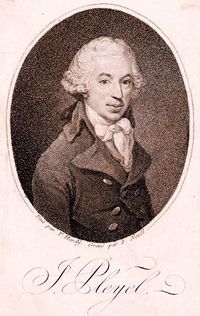Annotation:Duke of York’s Favourite: Difference between revisions
No edit summary |
m (Text replacement - "garamond, serif" to "sans-serif") |
||
| Line 1: | Line 1: | ||
=='''Back to [[{{BASEPAGENAME}}]]'''== | =='''Back to [[{{BASEPAGENAME}}]]'''== | ||
---- | ---- | ||
<p><font face=" | <p><font face="sans-serif" size="4"> | ||
'''DUKE OF YORK'S FAVOURITE.''' Scottish, March (2/4 time). B Flat Major (Watlen): G Major (Aird). Standard tuning (fiddle). AABAA. John Watlen, in his '''Celebrated Circus Tunes''' (Edinburgh, 1791) attributes the tune to composer Ignaz Pleyel [http://en.wikipedia.org/wiki/Ignaz_Pleyel] (1757-1831), born in Austria, who became a French citizen around the beginning of the Republic, and who managed to negotiate those troubled times, even though accused at one time of being a Royalist agent. When the revolutionaries in France banned public concerts and music in church in 1791, Pleyel sought employment in London, where he stayed for a few years, leading concerts in that city (as did his old teacher, Joseph Haydn, with whom he remained cordial). | '''DUKE OF YORK'S FAVOURITE.''' Scottish, March (2/4 time). B Flat Major (Watlen): G Major (Aird). Standard tuning (fiddle). AABAA. John Watlen, in his '''Celebrated Circus Tunes''' (Edinburgh, 1791) attributes the tune to composer Ignaz Pleyel [http://en.wikipedia.org/wiki/Ignaz_Pleyel] (1757-1831), born in Austria, who became a French citizen around the beginning of the Republic, and who managed to negotiate those troubled times, even though accused at one time of being a Royalist agent. When the revolutionaries in France banned public concerts and music in church in 1791, Pleyel sought employment in London, where he stayed for a few years, leading concerts in that city (as did his old teacher, Joseph Haydn, with whom he remained cordial). | ||
[[File:pleyel.jpeg|200px|thumb|left|Ignaz Pleyel]] | [[File:pleyel.jpeg|200px|thumb|left|Ignaz Pleyel]] | ||
| Line 7: | Line 7: | ||
<br> | <br> | ||
</font></p> | </font></p> | ||
<p><font face=" | <p><font face="sans-serif" size="4"> | ||
''Source for notated version'': | ''Source for notated version'': | ||
<br> | <br> | ||
<br> | <br> | ||
</font></p> | </font></p> | ||
<p><font face=" | <p><font face="sans-serif" size="4"> | ||
''Printed sources'': Aird ('''Selection of Scotch, English, Irish and Foreign Airs, vol. 4'''), 1796; No. 130, p. 50. Watlen ('''The Celebrated Circus Tunes'''), 1791; p. 30. | ''Printed sources'': Aird ('''Selection of Scotch, English, Irish and Foreign Airs, vol. 4'''), 1796; No. 130, p. 50. Watlen ('''The Celebrated Circus Tunes'''), 1791; p. 30. | ||
<br> | <br> | ||
<br> | <br> | ||
</font></p> | </font></p> | ||
<p><font face=" | <p><font face="sans-serif" size="4"> | ||
''Recorded sources'': <font color=teal></font> | ''Recorded sources'': <font color=teal></font> | ||
</font></p> | </font></p> | ||
Revision as of 12:33, 6 May 2019
Back to Duke of York’s Favourite
DUKE OF YORK'S FAVOURITE. Scottish, March (2/4 time). B Flat Major (Watlen): G Major (Aird). Standard tuning (fiddle). AABAA. John Watlen, in his Celebrated Circus Tunes (Edinburgh, 1791) attributes the tune to composer Ignaz Pleyel [1] (1757-1831), born in Austria, who became a French citizen around the beginning of the Republic, and who managed to negotiate those troubled times, even though accused at one time of being a Royalist agent. When the revolutionaries in France banned public concerts and music in church in 1791, Pleyel sought employment in London, where he stayed for a few years, leading concerts in that city (as did his old teacher, Joseph Haydn, with whom he remained cordial).

Source for notated version:
Printed sources: Aird (Selection of Scotch, English, Irish and Foreign Airs, vol. 4), 1796; No. 130, p. 50. Watlen (The Celebrated Circus Tunes), 1791; p. 30.
Recorded sources:
